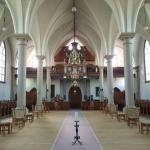1,000 years old
For more than 1,000 years the 3 Egmonden have been known first until a few years ago as an independent municipality, but after the merger the three villages are now also called Bergen, not only because the Sea has an almost magical appearance. Especially during the summer months when the sea lights up by “sea sparkle” it is then good to be on the beach.
Winter in Egmond
Even during the winter months you can get a breath of fresh air on the Egmond or Egmond-Binnen beach. During big storms, the Sea with all its strength is also very impressive, it is not for nothing that every few years beach replenishment is necessary to maintain the village of Egmond, we would not want the current Egmond to end up in the sea as in the 18th century.
Egmond aan Zee in Summer and Winter Everything on the Coast!!!
The dunes of the Egmonden are especially special because in addition to being a rich natural area, it has especially beautiful hiking and biking routes that give you the feeling of peace and relaxation. Walk delightfully through Egmond aan den Hoef along the stone path to Egmond and then take the first road left back into the dune and 5 km later you are back where you started.
The traditional use of the dunes certainly applies to the inhabitants of “De Egmonden”: Egmond aan Zee, Egmond aan den Hoef and Egmond-Binnen.
Thus it is thanks to them that the dune terrain at Egmond Binnen is still characterized by a reasonably intact inner dune edge with low dunes. Almost everywhere in the Netherlands this so-called mienten landscape has been converted into flower bulb fields (the geest grounds behind the dunes!). But the Egmond people have been grazing these lands with cows for centuries, leaving the landscape open.
Thanks to the combination of centuries of grazing and calcareous seepage water, these inner dune grasslands are also very flowery: in June they are red and yellow with the great rattle and reed orchids. From the Van Oldenborghweg you can see this landscape in all its glory; with a great view of Egmond Binnen with the characteristic contours of Egmond Abbey. The calcareous groundwater that drains to the surface here forms pools with rich amphibian populations in some places.
It is home to common toads, natterjack toads and salamanders, among others. The numerous pine plots in the dune terrain were created in the 1930s, as part of the labor supply. Unemployed people had to turn the soil three stitches deep and then plant 16,000 young pines per acre in it. Now these forests are about 70 years old and iconic in the dune landscape.
Entrances to the Egmond Dunes
Main entrances: Middenweg; The Pale
Accessed
Access from sunrise to sunset, on roads, trails and playgrounds
- Motorized traffic not allowed
- Dogs allowed, if kept on a short leash
- Cycling on unpaved trails allowed until 10:30 a.m. unless otherwise indicated.













